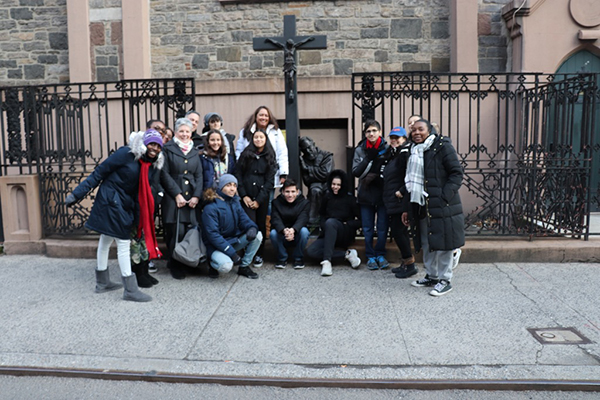
about the history of St. Patrick’s Old Cathedral, including its historic catacombs. (Photo: courtesy of St. Rose of Lima Youth Group)
By Diana Hernandez
Manhattan is a beautiful place (once you forget all the traffic, people shouting in the streets, construction, sirens and dogs barking).
But have you ever taken a deeper look, like underground?
In lower Manhattan, there is an old church that started construction in 1809 and completed in 1815, called St. Patrick’s Cathedral.
Since it is one of the oldest buildings in New York, you might think it is well-known.
Well, not exactly.
On Feb. 8, the youth group from my home parish, St. Rose of Lima, Rockaway Beach, went on a tour to see the underground catacombs at St. Patrick’s Old Cathedral Basilica. Little did I know this wasn’t just an ordinary church.
Our tour guide Ronny told us the history of the cathedral and explained the architecture of the church. I did not expect to come out with more knowledge than I had before. Ronny explained how St. Patrick’s Old Cathedral was built by immigrants. He also said how the church burned down from an accidental fire, caused by sparks from a nearby blaze.
He said, “It was as if the Cathedral vanished overnight.” There was only one stained glass window in the front of the church, behind the altar, that was left after the fire.
After he spoke about the history of the cathedral, we went across the street into the Cathedral’s graveyard. The graveyard looked like it was the set for a movie. The tombstones were worn out and looked old but you can still see very faintly the names of the person or people who were buried there.
People buried in the cemetery all contributed to making the church and the society a better place. After he finished talking about the cemetery, we walked to the front of the church and found out that this wasn’t exactly your normal church. On the floor outside is a glass window leading down to the catacombs. Although those steps aren’t still used today, I found that part to be very interesting.
When we entered the main part of the church, we saw the very tall ceiling, the beautiful stained-glass windows, and the very big, old organ that was once powered by hand. It has just a little under 2,500 pipes that let the sound travel out into the church. It’s called the Henry Erben Organ. After Ronny spoke about the history of this organ, we got to walk behind it and see all the pipes and the old wheel that powered it manually.
After we finished looking at the organ, we went to a part of this church that not many churches have: the catacombs. We went downstairs, into a room, and waited to go inside. We all received a tiny electric candle to help us see what was written on the stones.
As we walked, we read the stones of people who were buried there, very influential people, including the papal countess Annie Leary, the first American woman to receive this title from Pope Leo XIII in 1903. Another prominent figure buried in these catacombs is Thomas T. Eckert, an officer in the U.S. army that helped and worked with Abraham Lincoln.
My personal favorite part about this trip was the time spent with friends. I felt like I grew closer to the people in the youth group. When we all gathered for lunch a week later, we realized we connected through this trip that we all enjoyed. I am more than grateful to be part of such a welcoming, loving, and vibrant parish and youth group, and look forward to more trips like this in the future.
Hernandez is in eighth-grade and a member of the youth group at St. Rose of Lima, Rockaway Beach.
